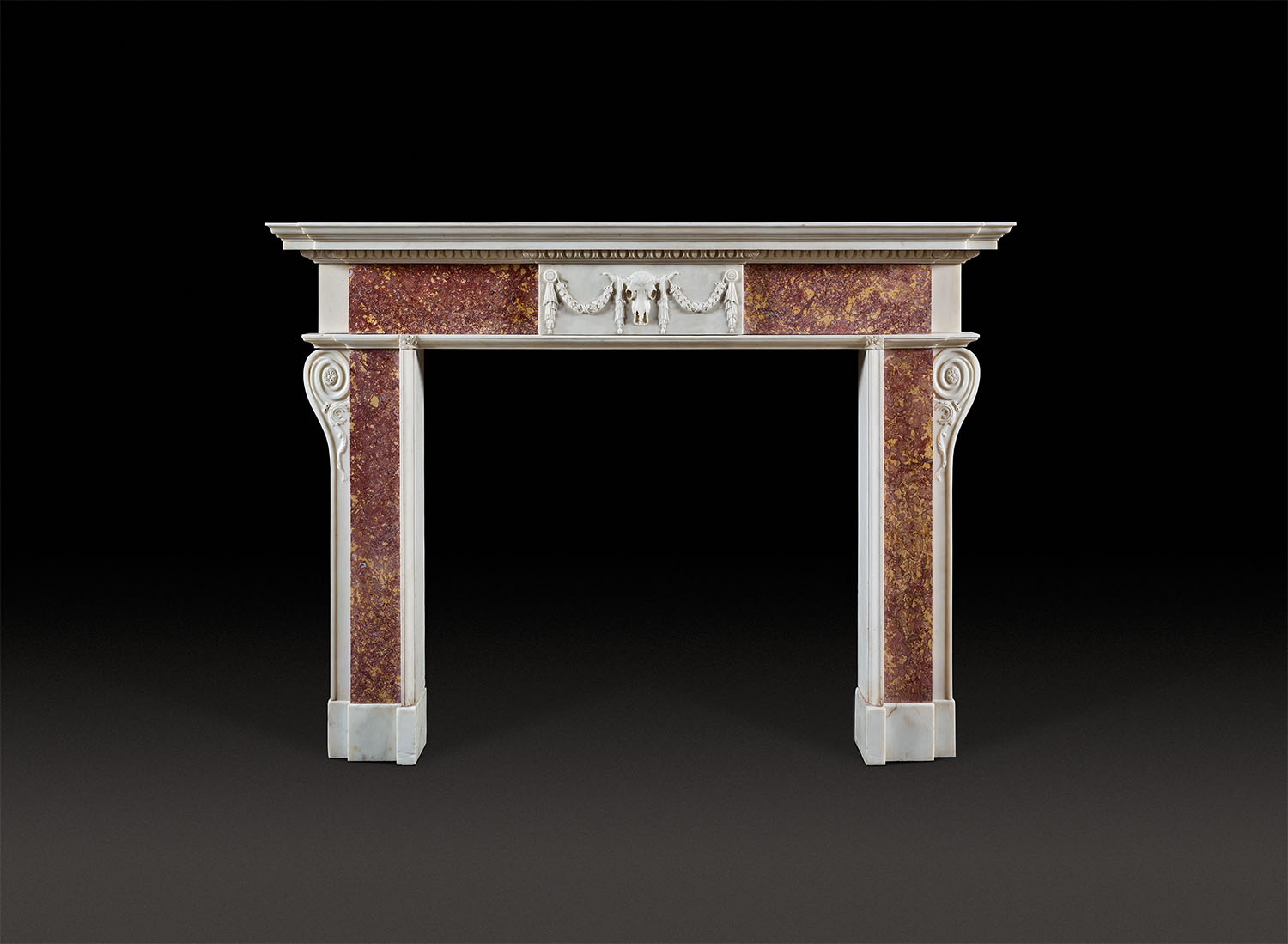
G190
An Imposing George III Neoclassical Chimneypiece of the Roman Doric Order
A superb George III Neoclassical antique fireplace of the Roman Doric order, in white statuary and Spanish Brocatelle marbles. The design attributed to Sir William Chambers (1723–1796), architect to the King. Circa 1765–1770.
The tiered shelf with egg and dart moulding (symbolic of good and evil), above the frieze, which is centred with a rectangular tablet, superbly sculpted with a bucranium mask of an ox skull. This has horns and a jewelled decoration adorns the skull above the eyes, the horns are draped with bunched, knotted ribbons, which hold swags of tied bell flowers, the other end of which are secured and fall from circular, flower decorated paterae. This is flanked by Brocatelle panels and recessed, statuary end blockings. The jambs with pilaster Brocatelle uprights, flanked by statuary out grounds with scrolling volutes decorated with sprigs of foliage. The opening with moulded edge, the whole raised on foot blocks.
The Doric Order with its boldness and robustness appealed to Chambers and his academic style, which was a sophisticated compound of French Neo-classicism and a refined English Palladianism. His chimneypiece designs have a sculptural monumentality, that characterised his work. In his 'Treatise on Civil Architecture', published in 1759, which quickly became the standard work on the use of the Orders, superseding, Issac Ware's 'Complete body of Architecture', he writes, “the Doric is next in strength to the Tuscan; and, being of a grave, robust and masculine aspect, is by Scamozzi called the Herculean, it is the most ancient of orders”. He illustrates the Roman Doric Order (though the Greeks might have been the first to give convincing form to the elements of architecture, Chambers thought that the Romans had brought the art to perfection).
Chambers used his Doric chimneypieces throughout all rooms of his buildings: hall (Paksted house, with bucranium mask), dining (Gower house, London), bed (Milton Abbey, with five bucranium masks). This is unlike his rival Robert Adam who always and only used them in entrance halls, the one exception being that found in the dining room at Osterly, which might have been designed by Chambers. We know of no extant chimneypieces with bucranium masks by Adam.
In the Victoria and Albert Museum, one design by Chambers of a Doric chimneypiece has survived. In pen and ink, pencil with grey and ivory washes, it has an almost identical, bucranium centre tablet (D1260–18980).
After Chambers returned to England from his Grand Tour, he visited Holkham Hall, Norfolk, in 1755 and sketched and annotated a bucranium decorated chimneypiece after a design by Inigo Jones, no doubt the inspiration for him later. This is now in the Victoria and Albert Museum (Franco Italian Album, VAM 5712.426, page 32).
The attractive Violet Brocatelle marble, with its shades of violet and yellow, came from the Tortosa quarry in Spain which was opened in Antiquity. Writing in his 'Treatise' (page 79), Chambers reports that “Chimneypieces are composed of wood, stone or marble, the last of which is to be preferred. All ornaments, figures, or profiles, are best when of the pure white sort; other parts may be made of marbles of variegated colours; such as the yellow of Sienna and the Brocatello of Spain.”
There is a surviving Chambers design for a nearly identical chimneypiece tablet in the V&A.
Height 56¾in (144.1cm) width 76¼in (193.4cm)
Internal height 43½in (110.5cm) width 47in (119.4cm)
Footblock to footblock 65¾in (167cm)
Shelf depth 8in (20.4cm)






